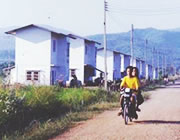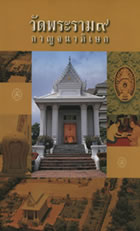The Royal Development Projects concerning public welfare provide assistance to the farmers in terms of general livelihood and occupational support. It facilitates the farmers’ life by providing land for cultivation and living as well as other facilities such as water sources. This way, the well-being of the people will be promoted. Examples of this type of project are:
Wat Yannasangvararam Areas Development Project, Chon Buri Province
Wat Yannasangvararam Areas Development Project, Chon Buri Province, intends to improve the deteriorated cultivated areas and restore their fertile conditions. It also serves as a centre of agricultural development service and simultaneously, spiritual development. This means the project supports spiritual development in parallel with the country’s economic and social development.
The Royal-initiated Huai Ongkod Project, Kanchanaburi Province
|

|
The Royal-initiated Huai Ongkod Project, Kanchanaburi Province, was born out of His Majesty’s initiative concerning land management which emphasized “the management of natural resources appropriate to the area conditions”. The project allocated to the villagers the land for residence, enabling the villagers to live and make a living in harmony with nature, without harming one another. This idea adheres to the principle of rehabilitation and creation of a balance in the ecological system while providing the fundamental infrastructure such as roads, electricity, schools, and hospitals, together with occupational training courses for the villagers. The goals of the project are to help improve the people’s well-being and provide means of making a living which coincide with the development and rehabilitation of the forests to their original rich condition. |
Rama IX Golden Jubilee Temple, Bangkok
|

|
Rama IX Golden Jubilee Temple, Bangkok, was built according to His Majesty the King’s wish to be a small and simple “temple” which can be used for maximum purposes and serve as a centre of spiritual unity of the community integrating the three poles: “Ban-Wat-Ratchakarn” or ‘Bavorn” in short. [Ban (residence) represents the people, Wat (temple) represents the monks or religion, and Ratchakarn (state) represents government agencies, and for this project, schools]. It is aimed to be a religious place and simultaneously a centre of spiritual unity where people gather to participate in various activities concerning religion, cultural practice and community development in the integrated and supportive manner which will lead to sustainability. |